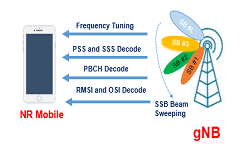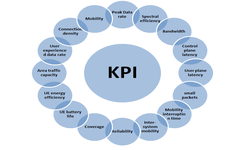5G NR Network Relationship – Neighbor Planning
In any telecommunication technology starting from 2G to 5G, Neighbor relation or to say Neighbor planning is an important activity. Neighbor relation information is very critical for cell re-selection while mobile device is in IDLE mode and for handovers when is it in mobility.
In older days, Radio Network Planner and Optimization engineer used to maintain neighbor relation manually with single RAT neighbor, configured during the system initial provisioning and bring-up. Many time neighbors configuration is missed and identified while doing network drive tests. As technology evolved, 2G start having 3 G nodes as neighbors and 4G use to have 3G/2G for Inter rate Mobility management. Thanks to Self Organizing Network (SON) features which make neighbor relation configuration easy and efficient. SON features adds neighbor automatically using network sniffing during bring up and later UE assisted and X2 neighbor update procedures.
Network Planning for 5G NR
In 5G Networks, the cell specific neighbor relationship is required for blacklisting specifics cells or applying power offset to a specific cell to bias cell re-selection in IDLE mode.
System Information Type#3 (SIB3), System Information Type#4 (SIB#4) and System Information Type#5 (SIB#5) for Intra frequency, Inter-frequency and Inter RAT cell for re-selection. SIB#4 and SIB#5 broadcast provides the frequency ARFCNs for inter frequency and I-RAT cell re-selection. 3GPP Eelease 15 has introduced System Information Type#24 (SIB#24) to broadcast the information for cell re-selection for 5G NR Cells.
Types of Neighbor
As we know that there can be two types of deployment possible for 5G NR, i.e Stand Alone (SA) and Non Stand Alone (NSA) mode. So we can categorize neighbor relation based on the above deployments mode.
- SA Deployment Neighbor Relations
- NR – NR neighbors: A NR cell can have another NR cell as an intra frequency neighbor (operating on same frequency) or inter frequency neighbor ( operating on different frequency)
- NR – LTE neighbors : An operator may have deployed both 4G and 5G networks, then LTE cell can be used as inter RAT neighbor.
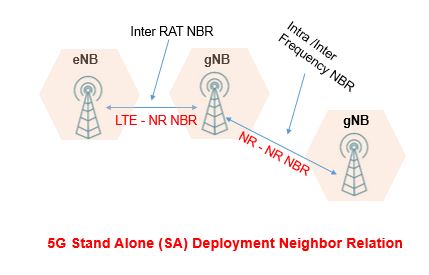
- NSA Deployment Neighbor Relations
- LTE- LTE neighbors: A LTE cell can have another LTE cell as intra frequency neighbor or inter frequency neighbor
- LTE – NR neighbors: A LTE cell can have NR cell as an EN-DC neighbor which can be added through X2 setup with secondary node addition procedure for primary SCG cell
- NR – NR neighbors: NR to NR cell neighbor relation can be used to change the primary SCG cell. This primary SCG cell change can be intra gNB or inter gNB. As a network planning guideline, at-least neighbor relation should be defined with adjacent NR gNB sectors.
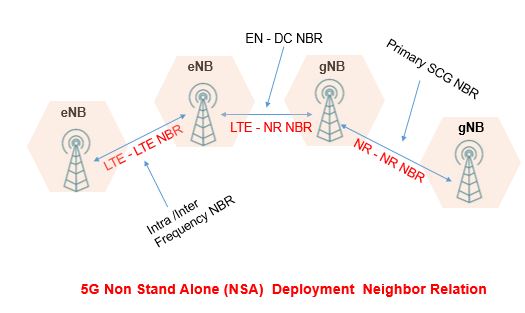
Neighbor Planning and Management:
As a first level , the NBRs relation can be generated manually or RF planning tool. A general guideline, while defining the neighbor relations, the planning engineer should perform a check of Physical cell IDs for adjacent neighbor to avoid PCI collision and PCI confusion situations, these can impact the Handover and Throughput KPIs of network.
The first level of NBRs relation can be provisioned in the initial configuration of system. Some system support sniffing of surrounding network (specifically small cells), where it can scan and get the NBRs information of already on-air cells by decoding broadcast information. One the system is up and operation, the further NBRs can be added through UE assisted ANR and eNB config update procedures over X2AP.
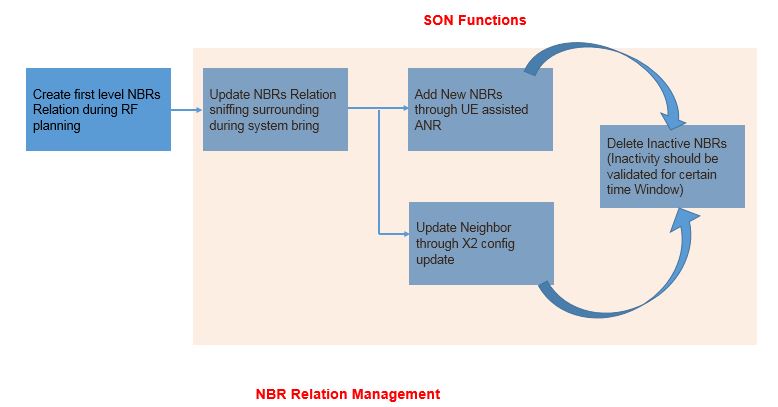
UE assisted ANR helps SON to populate NBRs relation based on measurement reports from UE, Whenever UE reports an PCI SON function checks if the PCI is available in the NBR relation table, if it is not available then it may ask UE to report CGI (Cell Global Identifier), where UE read the SIB#1 information of NBR cell and report to serving base station. UE assisted ANR can be configure based on measurement Event or can be periodic, the periodicity can defined by operation as it may impact the overall cell average throughput KPIs because, every time UE is measuring and decoding NBRs cell information, it needs to go into measurement gap period and data scheduling during gap period is not allowed.
So if the periodicity of UE assisted ANR is too frequency, then UE will go in measurement gap very frequency which may impact the User experiences. The UE assisted ANR may not be possible for NSA deployments because in EN-DC configuration NR base station does not broadcast the SIB#1 information which result in UE will not be able to decode and report the CGI information. Additionally, if NR base station is not connected to MME (only user plane connected) then the transport layer information to setup X2 between LTE and NR will not be available via tunnel discovery procedure
Further more, 5G network deployments are expected to be very dense and there can be situations where some of the base station go-off the air and become on-air. This requires the NBR relation to be dynamic, the NBR which are not used for long period can be delete and new NBRs reported via UE assisted ANR and X2 assisted ANR be added to make a clean NBR relation table.
Related Posts:
- 5G Network RF Planning – Link Budget Basics
- 5G mm Wave 28GHz Band Link Budget-n257
- 5G NR Physical Cell ID (PCI) Planning
- 5G NR Network Relationship – Neighbor Planning


